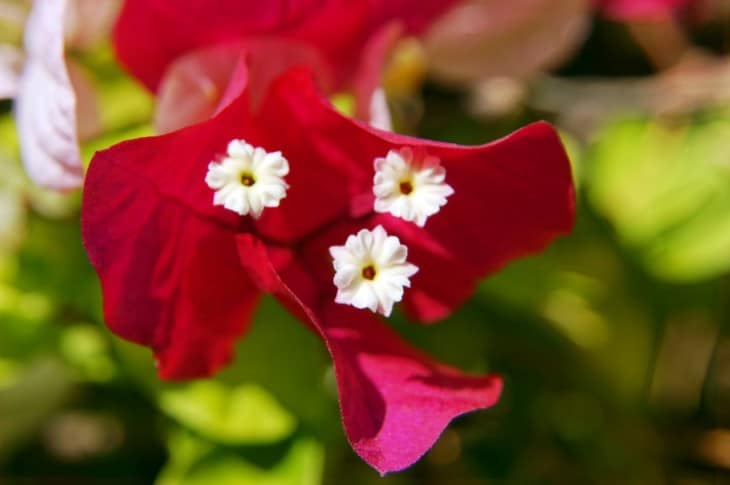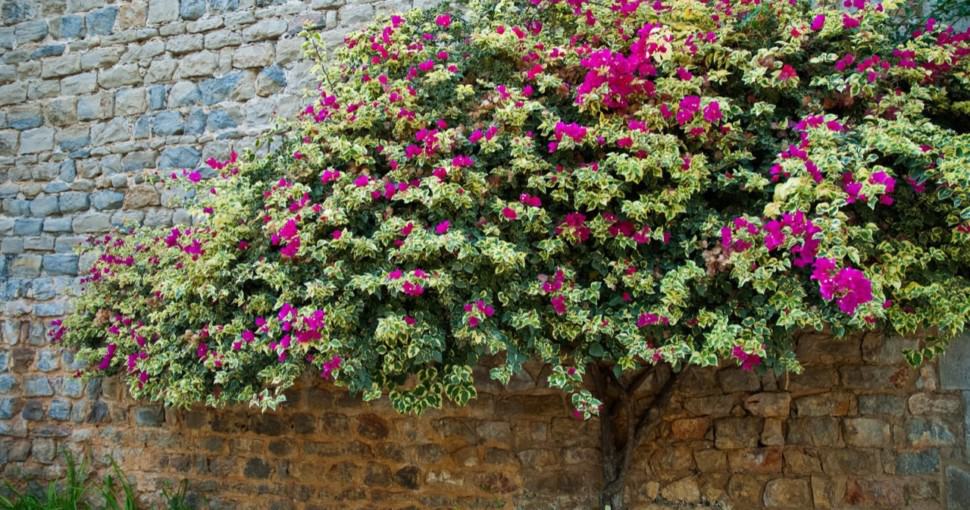Bougainvillea plants are native to Brazil. They are popular perennials for the garden because they are quick growers and produce beautiful and showy flowers. Bougainvillea is adaptable to many different soil types and will thrive in USD hardiness zones of 9 – 11. It is also drought tolerant. It is a garden favorite for many, but it can pose some dangers for the unwary.
Contents
- Are Bougainvillea’s Poisonous To Humans?
- Are Bougainvillea’s Poisonous to Dogs?
- Are Bougainvillea’s Poisonous To Cats?
- Are Bougainvillea’s Poisonous To Livestock?
- Treating Bougainvillea Cuts And Scrapes In Humans
- Treating Bougainvillea Cuts And Scrapes In Your Pets
- Safety Measures For Planting And Maintaining A Bougainvillea
The bougainvillea sap is mildly toxic, causing illness if ingested in large quantities. Symptoms include nausea, vomiting, and diarrhea. If a thorn pricks you, you can get dermatitis. Symptoms include itching, pain, stinging, blisters, burning skin, swelling, scaly rash, and sores.
Are Bougainvillea’s Poisonous To Humans?
Bougainvillea plants have thorns all along their branches under each leaf, and you will often find them planted along garden perimeters for security purposes. A waxy-looking substance coats the thorns, and if a person manages to pierce their skin with one of these thorns, an allergic reaction can occur.
This allergic reaction presents itself in the form of dermatitis, which is an itchy skin rash. Dermatitis resulting from skin puncturing from a bougainvillea plant can cause different symptoms depending on the person. These symptoms include itching of the affected area, swelling, mild to moderate pain, stinging, scaly rash, and even sores and blisters in severe cases.
Minor scratches, cuts, and splinters from bougainvillea plants can also cause infections if not treated properly. Thorn splinters are especially dangerous if you do not get all of the thorns out of your skin.
The leaves of the bougainvillea plant are also mildly toxic because of the sap they contain, but only if consumed in large quantities. Most adults will be fine if they consume the leaves of a bougainvillea plant, but children are more susceptible to reacting to bougainvillea consumption.
The symptoms of this include nausea, diarrhea, and vomiting. Contacting your local doctor in these situations would be a good idea.

Are Bougainvillea’s Poisonous to Dogs?
Bougainvillea plants are generally considered safe for dogs. It isn’t very likely that animals will eat any plant material, such as leaves.
If your pet has decided to make a snack of this plant, the best course of action would be to watch them for any signs of pain or irritation. If they show any of these signs, you should contact your local veterinarian to decide which course of action you should take.
The bougainvillea’s thorns can cause injury to a dog if they come into contact with one. The most usual outcome is that your dog gets some cuts or scrapes from the thorns, and this can cause itchy or irritated skin.
Are Bougainvillea’s Poisonous To Cats?
The overall consensus is that bougainvillea plants are non-toxic to cats. You might find that if your cat happens to ingest some of this plant, they may experience some oral irritation, which might cause some nausea or salivation.
The thorns can cause some mild skin irritation if they manage to puncture your cats’ skin, although research shows that cats are not as sensitive to this as, say, humans and dogs might be.
If you discover that your cat has a lasting or severe reaction to consuming some leaves or being scratched by a thorn from a bougainvillea plant, the best action would be to contact your vet for further treatment or advice.
Are Bougainvillea’s Poisonous To Livestock?
As is the same with cats, bougainvillea plants are considered non-toxic to livestock. Livestock, including horses, chickens, and goats, would need to consume large quantities of the leaves for them to have an adverse reaction. Deer and other animals will also have mild to non-existent physical responses if they ate the leaves or came into contact with a thorn from a bougainvillea plant.
These animals might have a mild to moderate skin reaction if they happened to get scraped or cut by one of the bougainvillea’s thorns.
Treating Bougainvillea Cuts And Scrapes In Humans
The best treatment for skin problems caused by the thorns of a bougainvillea plant is to get some antihistamine or hydrocortisone over-the-counter cream and treat the affected area for a few days. If you have gotten a bougainvillea thorn stuck in your skin, ensure you get all the pieces out to prevent infection.
If you find that your symptoms are not going away after two or three days, you should get hold of your local doctor about the best course of action you should take.
Treating Bougainvillea Cuts And Scrapes In Your Pets
You can treat these cuts and scrapes with warm soapy water, and you can also use a cold compress to help alleviate the itching and pain. If the symptoms do not clear up in a few days, you should contact your vet for further treatment.
Safety Measures For Planting And Maintaining A Bougainvillea
When planning on where you will plant your bougainvillea plant, there are a few things you should keep in mind. These are:
- Make sure you grow your bougainvillea at least 4 feet from walkways, doors, or enclosed spaces, to prevent the thorns from being able to scratch passersby.
- Do not plant them near swimming pools, playgrounds, or areas that get a lot of foot traffic from pets or children.
- Plant bougainvillea’s 6 – 9 feet away from other plants so that they have enough room to grow.
- Secure your bougainvillea with an arbor or trellis, making sure you secure their long shoots – this will prevent the sprouts from whipping around when it is windy.
- Regularly maintain and trim your bougainvillea, preventing out of control growth.
The ideal time to prune your bougainvillea is at the end of a blooming cycle. Pruning your bougainvillea at the right time will promote budding and branching. Although, you can prune your bougainvillea at any time of the year as these plants follow a bloom and then rest cycle, whether they get trimmed or not.
Pruning should include removing any overgrown or wayward branches before their length becomes a problem and your bougainvillea grows out of control. Doing this will encourage your plant to grow in proper shape.







